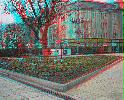Messages on Anaglyphs group
Post on Anaglyphs group
Viewed
 (326K)
(326K)Thanks for your comments!
I agree, what is well visible , it is good!
But I think, that we can define the situations with more accuracy :-))))
For my opinion the 1/30 rule ( 1 base and 30xbase from the nearest point ) is a very very GOOD rule, but it is used badly.
The 1/30 rule is a rule for avoid the diplopia problems caused by an object what is on the image and does occlusion with the farest point, what is the horizont.The occlusive object can be on the stereo window or can be farther. For example: 10 cm of base, so the object at 3 meters what does occlusion with the horizont, will be well visible on our anaglyph image. It is secondary where it is, directly on the window or fatrther.
So the 1/30 rule is valid for this occlusive object and NOT for all the stereo window, if this object is farther than the window. In other words: the nearest object for the 1/30 rule isnt the first visible point on the image ( like the bitumen of the street before me ), but is the first object what is with oclusion with the horizont. Other objects, what arent in occlusion and are nearer, can be photographated without problem.
I send a gif image. I painted an occlusive object on my anaglyph, one is at 3 meters ( I used 10 cm of base) and two nearer.
Well visible the diplopia on the images, where the occlusive object is nearer than 3 meters. Otherwise the real NEAREST object on the anaglyph is about 0,5 meter ( the real near point).
I think this is constructive.
Best regards: Imre